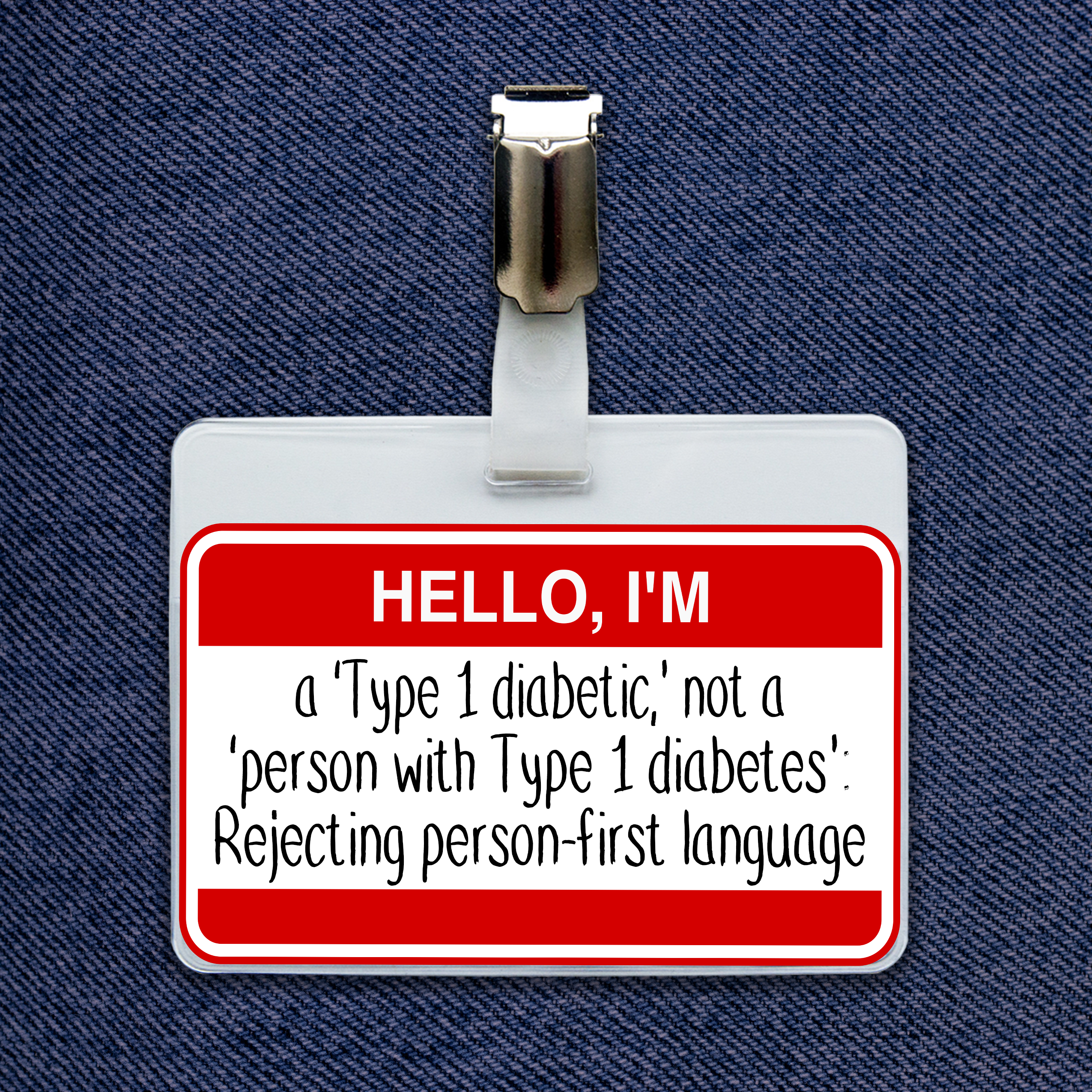As a Type 1 diabetic, I’ve been taking insulin for almost 10 years. A few years ago, I decided to explore why my medications cost so much. I started researching, and emailed the leader of a prominent diabetes advocacy organization. But instead of answering my questions, she told me that the way that I was referring to myself—I called myself a “Type 1 diabetic” in the email—was wrong.
She told me I need to use person-first language (PFL) rather than use identity-first language (IFL). In other words, she wanted me to say that I am a “person with Type 1 diabetes,” rather than a “Type 1 diabetic.”
At the time, I didn’t know what PFL was, and felt confused and embarrassed. How was the way that I referred to myself—and the way all the other Type 1 diabetics in my life referred to themselves—wrong?
PFL proponents argue that because it places the person before their disability in sentence structure, PFL emphasizes disabled peoples’ personhood instead of their diagnosis. But what person-first language fails to recognize is that disability is an essential part of identity for many disabled people, and it’s one that they shouldn’t have to minimize or separate from their personhood.
Person-first language has origins in the People First movement of the late ’60s and early ’70s, but it gained more momentum in 1992 when the American Psychological Association endorsed PFL (they later adapted their guidelines). Since then, PFL has been institutionalized as a linguistic norm in academic, healthcare, and political settings—including within powerful organizations like the Centers for Disease Control and Prevention. In fact, as of 2006, official D.C. laws, regulations, articles, and publications are required to use person-first language.
Yet PFL is a norm that many non-disabled people have attempted to universalize, regardless of personal linguistic preferences within the disabled community. While some disabled people are fine with PFL, many prefer IFL, especially in recent years. As a disabled person myself, I have personal motivations for preferring IFL.
I was diagnosed at 11 years old with Type 1 diabetes (T1D), a chronic autoimmune condition for which there is no cure. For me and all other Type 1 diabetics, our disability is a major part of our daily lives. There are treatments: daily insulin injections (or continuous insulin infusion through a pump) and constant monitoring of blood sugar levels, but managing T1D is a 24/7 responsibility. With no possible prevention measures or cures, I will be a Type 1 diabetic for the rest of my life.
To de-emphasize that fact by suggesting I position it as a grammatical afterthought is to diminish just how important my T1D is.
Not only that, but person-first language also further stigmatizes many already-stigmatized conditions by suggesting that personhood is distant from and incompatible with disability. T1D, for example, is already a heavily stigmatized illness. In a country that values thinness so highly, just the word “diabetes” can feel controversial (the more common Type 2 diabetes is correlated with obesity and a sedentary lifestyle). With a host of visible medical devices on my body at all times, it’s impossible to hide from this stigma.
PFL takes away my agency to accept my T1D as a part of who I am. It just adds to this ever-present stigma and makes it seem as though my T1D is something to be distanced from or ashamed of.
For me, using identity-first language is a sign of solidarity. I’m not afraid to identify first as a member of a marginalized community. Other disabled people and activists agree, pointing out how being disabled is an essential part of their identities.
The Deaf community in particular has embraced this idea. The capitalized “Deaf” refers to people in the Deaf community with a shared culture and language, while the lowercase “deaf” refers to people who do not hear, but may not share the culture of the Deaf community. Here, too, identity-first language signals community membership: To call a Deaf person a “person experiencing deafness” not only separates a Deaf person from this community, but also reduces that culture.
And there are bigger problems facing the disabled community than whether to call someone a “diabetic” or “a person with diabetes.” Disabled people—especially those without insurance—face enormous medical bills, a lack of accommodations, and other barriers to full equality. These issues tend to be far more important to the disabled community than linguistic details.
Practically, person-first language is more convoluted than identity-first language; it focuses on semantics, rather than producing meaningful change. It can often take on a tone of performativity. What does it matter if you refer to me as a “person with diabetes” or a “diabetic,” if either way, I still can’t afford my insulin?
Some activists argue that IFL reduces people to their disability. They say that using PFL to say that they “have a” disability gives them power over it—as opposed to suggesting that a disability “has” them, as IFL might suggest.
For me, saying, “I’m a Type 1 diabetic” doesn’t make it feel like I’m only my identity, but that it’s important to my identity. It’s like saying, “I’m a Georgetown student,” “I’m a redhead,” or “I’m a writer”—which doesn’t reduce personhood, but rather emphasizes an important component of identity.
We shouldn’t shy away from the direct discussions of disability that happen through IFL. Especially in regards to healthcare, medical leave, and other politically relevant topics, viewing disabled people as a group with an inherent, shared interest—rather than people who simply “have” something—is a first step.
Neither the use of person-first nor identity-first language should be mandated or policed: Rather, they should be used when specific contexts call for them (like if someone specifically requests that you use one or the other, or it just makes sense grammatically). The people who decide how language is used to describe this community should be disabled people, not non-disabled people.
Outside of discourse around disability, there are contexts where person-first language should be used. Certain communities, like people experiencing incarceration, utilize PFL, and we should adhere to their linguistic preferences. Those communities, however, reflect temporary conditions; for many disabled people, their identity is chronic and lifelong. So for many within the disabled community, using IFL is just as acceptable as PFL—if not more.
All disabled people should be able to choose how they would like to be referred. I have no shame in having T1D—in fact, I feel proud to be part of a community that has overcome extreme stigma, expensive (and rising) medical costs, the challenges of balancing blood sugar levels, and more. The non-disabled community should focus less on regulating language around disability and more on productively supporting the disabled community, advocating for accommodations and affordable healthcare.
So you can call me a Type 1 diabetic, or you can call me a person with T1D. But when I talk about myself, I’m going to continue to put my disabled identity first: I’m a Type 1 diabetic.






Some type-1 diabetics do not think of T1D as a part of who they are. Thank you for the interesting article.
Type 1 diabetes is a serious disease that requires daily insulin injections and careful management of diet and exercise.
As a Type 1 Diabetic myself, I agree. I really enjoyed reading this!